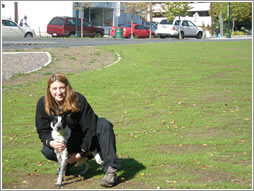The newest member of the Mill River Collaborative team arrives at Mill River Park on Tuesday after months of special training for her new assignment. Kate, the Collaborative’s new border collie, will be in charge of keeping the geese from fouling the park lawns and walks with their profuse droppings.
“In a park, you should be able to lie on the grass on a summer day and contemplate the clouds,” said Milton Puryear, Executive Director of the Mill River Collaborative. “But after the geese have been there, who would ever want to?” Voracious eaters of grass, Canadian geese often leave bare patches and loops of poop where grass was struggling to grow.
Kate will tackle these challenges head on by keeping the geese moving. Border collies are uniquely qualified for this due to their herding style. Unlike other herding dogs, border collies do not bark or make a big display of their presence. On the contrary, they silently stalk, crouched like a predator, though never touching or hurting the geese. This unnerves the geese, who won’t want to nest in Kate’s territory and will find greener pastures to munch and to foul. |
 |

 click image for larger view click image for larger view |
Two year-old Kate’s training started with learning how to herd sheep. She learned to follow hand and voice signals from her handler to precisely move the sheep in accordance with the handler’s instructions. Mill River Ambassador Jessica Curtis will be Kate’s new handler. The team will be in the park most days to establish it as Kate’s territory. After mastering sheep, Kate’s training was transferred to herding geese, first on land and then in the water.
According to a course on “Geese Management” offered by Connecticut Department of Environmental Protection, the geese that live year round in our parks and golf courses have no collective memory of migrating. They are the offspring of geese that escaped from game farms starting in the 1940s and 1950s. Their populations have grown dramatically in part because they have no natural predators. The quality of their food supply is also a key factor in their growing numbers. Highly fertilized lawns make up a large part of their diets. This contributes to larger clutches of up to seven eggs per nest versus three in the wild. |